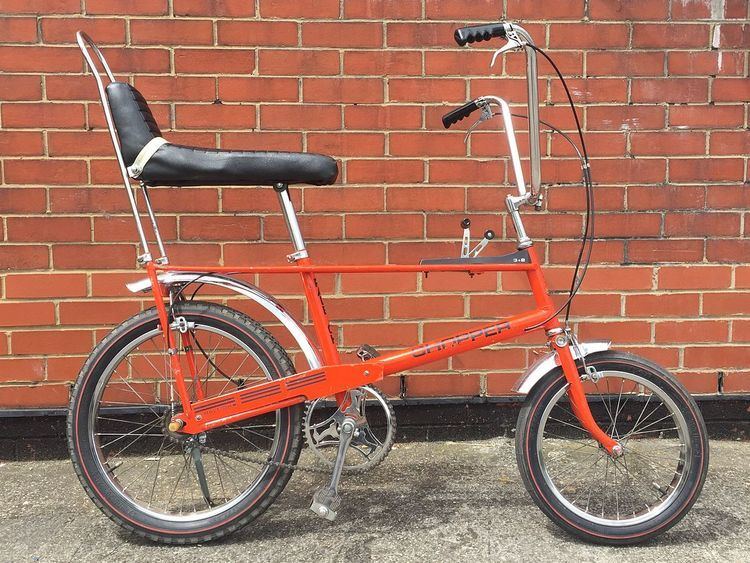 | ||
The Raleigh Chopper is a children's bicycle, a wheelie bike, manufactured and marketed in the 1970s by the Raleigh Bicycle Company of Nottingham, England. Its unique design became a cultural icon, and is fondly remembered by many who grew up in that period. Influenced by dragsters, motorbikes, beach buggys, and even Chariots, which can be seen in the 1969 Raleigh US catalog on the centre page.
Contents
The UK launch in 1970 was branded as 'THE HoT oNE'. The Chopper bike was the "must have" item and signifier of "coolness" for many children at the time.
Design
The Raleigh Chopper's design has been a constant debate with claims by both Tom Karen of Ogle Design and Alan Oakley of Raleigh. The Chopper was designed in response to the Schwinn Stingray, and an earlier attempt, called the Rodeo, was not commercially successful. The popularity of the Chopper also led to a range of smaller bikes following a similar design theme. These included the Raleigh Chipper, Tomahawk, Budgie and Chippy models, aimed at younger riders.
Mk 1
The Chopper's patent was applied for in the US in 1967. The Chopper was introduced at American trade shows in January 1969 but it was not until April 1969 when Raleigh Choppers were available for public to purchase . The bike featured a choice of a single-speed coaster hub, or a 3-speed or 5-speed Sturmey Archer gear hub, selected using a frame-mounted console gear lever — one of its "cool" features. Other features that appealed to the youth market were the unusual frame, long padded high-back seat, sprung seat at the back, high-rise (ape hanger) handlebars, 'bobbed' mudguards (fenders) and differently sized wheels — 16 in (41 cm) front and 20 in (51 cm) rear. The rear hoop above the seat resembled a dragster anti roll bar "sissy bar". Even the kickstand was designed to give the stationary bicycle a lean reminiscent of a parked motorcycle. Tyres were wider than usual for the time, with a chunky tread on the rear wheel, featuring a red line around the sidewall. In 1970 the Raleigh Chopper was launched in the UK market this was a triple launch for Raleigh, with the Chopper branded as THE HoT oNE, alongside the Moulton Mk3 (The Smooth One), and the RSW Mk3 (The Dolly One).
Mk 2
The Mk 2 ("Mark 2") Chopper was an improved version from 1972. It had the rarely-purchased option of five-speed derailleur gears, and the gear lever shifter changed from a knob to a T-bar-style shifter. The frame was subtly revised, and the seat moved forward, to help prevent the front of the bicycle tipping up. A small rear rack was added. The handlebars were welded to the stem to stop children from inclining the "ape hanger" bars backward, thereby rendering the bicycle almost unsteerable. A drop-handlebar version, the Sprint, was also produced, this differed from the standard Mk 2, as it had a slightly taller frame. The Chopper remained in production until 1982, by which time the BMX craze had taken over its market. However, the Chopper almost single-handedly rescued Raleigh, which had been in decline during the 1960s, selling millions worldwide.
Handling and safety
The original Chopper is fondly remembered, though it was not without problems: It was less stable than a conventional bicycle, and trickier to ride. It was slow and heavy, the wide tires creating significant rolling resistance; the Chopper was not suitable for long distances. At moderate speeds it suffered speed wobbles. After several reported accidents, it was attacked in the press as a dangerous toy. The long seat lent itself to giving lifts to others, and accidents were not uncommon. It could perform involuntary wheelies readily, again a frequent cause of accidents. The position of the gear lever could also contribute to injuries sustained in a crash.
Original models
UK Market
US Market
The North American market saw a much wider spectrum of models and colours/colors available. In 1971 there was a ban on tall sissy bars so the chopper was only sold with a low back rest. A quick summary of models as follows;
The Eatons Connection
The Raleigh Chopper was also sold through Eatons of Canada badged as Gliders, sold as the Fastback 100, Fastback XT101, SS357, ULT, Princess, and MACH-2 models.
Worldwide phenomenon
Raleigh sold the Chopper to many countries worldwide, in some countries Raleigh chose to sell Choppers badged up differently, these included; BSA, Hercules, Humber, Malvern Star, Phillips, Robin Hood, Rudge, and Speedwell Fireballs..
Imitators
The runaway success of the Chopper led to many similarly styled imitators, such as the Pavemaster Trusty Tracker, Triang Dragster, Dawes Zipper, Panther and Vindec High Riser in the UK as well as the very close copy of an Mk 2 named "Cincoa" and in more recent years the Ground Cruiser which was sold in England at the same time as the release of the MK 3.
Revival: Mk 3
A new version of the Chopper, the Mk 3, was launched in 2004, after being out of production for almost 25 years. The Mk3, in deference to modern safety concerns, adopts a more conventional saddle design to discourage "backies", and has dropped the groin-catching gear lever in favour of handlebar mounted gear controls; to commemorate this former feature the Mk 3 has a sticker where the lever once was. The frame is made from aluminium alloy tubing, rather than the originals' steel, to make the bicycle lighter. The wheels are again 20 inches for the back wheel and 16 for the front wheel. The MK3 is still in production to this day.
